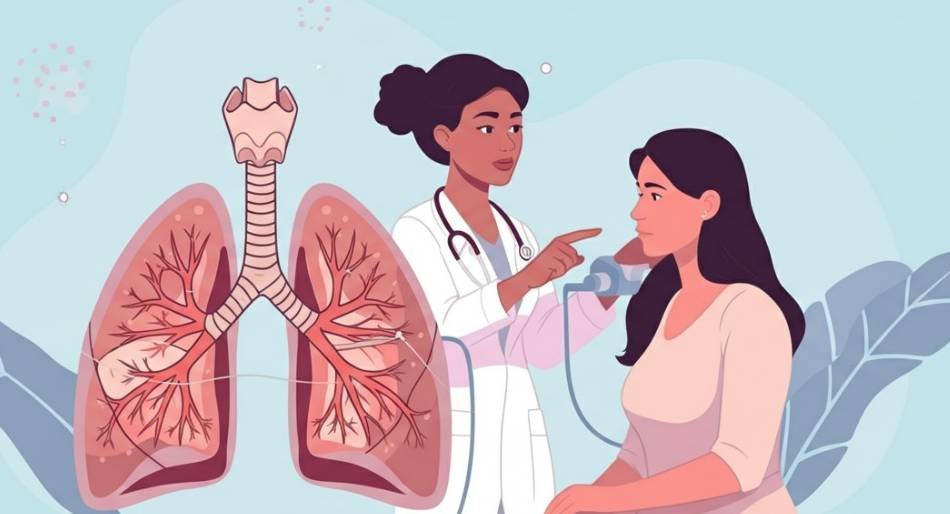Pulmonary Function Tests (PFTs) Information
1. What are PFTs?
Pulmonary Function Tests (PFTs) are a group of non-invasive diagnostic procedures that measure how well your lungs take in and release air and how efficiently they transfer oxygen into the bloodstream. These tests are a vital tool in the diagnosis and management of various respiratory conditions.
PFTs evaluate several aspects of lung function:
- Lung volumes and capacities: How much air your lungs can hold
- Flow rates: How quickly you can move air in and out of your lungs
- Gas exchange: How efficiently oxygen enters your bloodstream and carbon dioxide is removed
As described on Dr. Nalini’s pulmonary services page, PFTs are “a simple and effective test to evaluate lung function and aid in diagnosing respiratory conditions.”
2. When are PFTs recommended?
Pulmonary Function Tests are recommended in various situations:
- Diagnosis of respiratory conditions: To help identify conditions like asthma, chronic obstructive pulmonary disease (COPD), or interstitial lung disease (ILD)
- Assessment of disease severity: To determine how advanced a lung condition is
- Monitoring disease progression: To track changes in lung function over time
- Evaluating treatment effectiveness: To see if medications or other treatments are improving lung function
- Pre-operative evaluation: To assess surgical risk for patients with known or suspected lung disease
- Occupational screening: For workers exposed to lung irritants or pollutants
- Research purposes: To study lung function in clinical trials
PFTs are particularly important if you experience symptoms such as:
- Persistent cough
- Shortness of breath
- Wheezing
- Chest pain or tightness
- Decreased exercise tolerance
3. Types of Tests
Several types of Pulmonary Function Tests evaluate different aspects of respiratory health:
Spirometry
The most common PFT measures how much air you can breathe in and out and how quickly you can exhale. Key measurements include:
- FVC (Forced Vital Capacity): The total amount of air you can forcefully exhale
- FEV1 (Forced Expiratory Volume in 1 second): How much air you can exhale in the first second
- FEV1/FVC ratio: Helps distinguish between obstructive and restrictive lung diseases
Lung Volume Tests
These measure the volume of air in your lungs, including areas that may remain filled with air during normal breathing. Tests may include:
- Total Lung Capacity (TLC): The total volume of air in your lungs
- Residual Volume (RV): The air remaining in your lungs after maximum exhalation
- Functional Residual Capacity (FRC): The volume of air in the lungs after normal exhalation
Diffusion Capacity Tests
Measures how efficiently oxygen moves from your lungs into your bloodstream. This test is crucial for diagnosing:
- Interstitial lung diseases
- Pulmonary vascular diseases
- Early emphysema
Bronchoprovocation Testing
Evaluates airway reactivity by deliberately introducing triggers to see if they cause bronchoconstriction (airway narrowing). Common triggers include:
- Methacholine
- Exercise
- Cold air
- Allergens
4. Interpreting results
When interpreting PFT results, specialists like Dr. Nalini Nagalla consider:
Normal vs. Abnormal Values
Results are compared to predicted normal values based on your:
- Age
- Height
- Gender
- Ethnicity
Results are typically expressed as a percentage of the predicted values, with readings below 80% generally considered abnormal.
Obstructive vs. Restrictive Patterns
- Obstructive pattern: Shows reduced airflow (low FEV1/FVC ratio), common in conditions like asthma and COPD
- Restrictive pattern: Shows reduced lung volumes (low TLC, FVC) but normal or high FEV1/FVC ratio, standard in pulmonary fibrosis and neuromuscular disorders
Severity Classification
Results help classify disease severity as follows:
- Mild
- Moderate
- Severe
- Very severe
This classification guides treatment decisions and helps track disease progression over time.
5. FAQs about PFTs
How should I prepare for a PFT?
- Avoid smoking for at least 6 hours before the test
- Avoid heavy meals before testing
- Wear loose, comfortable clothing
- Avoid vigorous exercise before the test
- Check with your doctor about whether to take your regular medications before testing
Are PFTs painful?
No, PFTs are non-invasive and painless. Some patients may experience mild shortness of breath or coughing during the tests, but these effects are temporary.
How long do PFTs take?
Basic spirometry takes about 15-30 minutes. More comprehensive PFT sessions may take up to 90 minutes.
How often should PFTs be repeated?
For monitoring chronic conditions like asthma or COPD, tests may be performed every 6-12 months or whenever there’s a significant change in symptoms.
Can children undergo PFTs?
Yes, PFTs can be performed on children as young as 5-6 years old, provided they can follow instructions. Special pediatric equipment and techniques may be used.
What if my PFT results are abnormal?
Abnormal results will be discussed with you by your pulmonologist, who may recommend additional testing or treatment options based on your specific condition.
For comprehensive pulmonary care, including Pulmonary Function Tests
Book an appointment with Dr. Nalini Nagalla, a pulmonologist with over 24 years of experience specializing in respiratory health.
Visit the book appointment page or call +91 80080 47020 to schedule your consultation.

